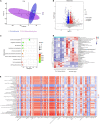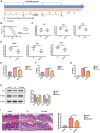Intestinal Flora-Derived Kynurenic Acid Protects Against Intestinal Damage Caused by Candida albicans Infection via Activation of Aryl Hydrocarbon Receptor
- PMID: 35923391
- PMCID: PMC9339982
- DOI: 10.3389/fmicb.2022.934786
Intestinal Flora-Derived Kynurenic Acid Protects Against Intestinal Damage Caused by Candida albicans Infection via Activation of Aryl Hydrocarbon Receptor
Abstract
Colonization of the intestinal tract by Candida albicans (C. albicans) can lead to invasive candidiasis. Therefore, a functional intestinal epithelial barrier is critical for protecting against invasive C. albicans infections. We collected fecal samples from patients with Candida albicans bloodstream infection and healthy people. Through intestinal flora 16sRNA sequencing and intestinal metabolomic analysis, we found that C. albicans infection resulted in a significant decrease in the expression of the metabolite kynurenic acid (KynA). We used a repeated C. albicans intestinal infection mouse model, established following intake of 3% dextran sulfate sodium salt (DSS) for 9 days, and found that KynA, a tryptophan metabolite, inhibited inflammation, promoted expression of intestinal tight junction proteins, and protected from intestinal barrier damage caused by invasive Candida infections. We also demonstrated that KynA activated aryl hydrocarbon receptor (AHR) repressor in vivo and in vitro. Using Caco-2 cells co-cultured with C. albicans, we showed that KynA activated AHR, inhibited the myosin light chain kinase-phospho-myosin light chain (MLCK-pMLC) signaling pathway, and promoted tristetraprolin (TTP) expression to alleviate intestinal inflammation. Our findings suggest that the metabolite KynA which is differently expressed in patients with C. albicans infection and has a protective effect on the intestinal epithelium, via activating AHR, could be explored to provide new potential therapeutic strategies for invasive C. albicans infections.
Keywords: aryl hydrocarbon receptor; intestinal barrier function; intestinal flora; invasive C. albicans infections; kynurenic acid.
Copyright © 2022 Wang, Yin, Qi, Zhang, Zhu and Tang.
Conflict of interest statement
The authors declare that the research was conducted in the absence of any commercial or financial relationships that could be construed as a potential conflict of interest.
Figures







Similar articles
-
Tryptophan metabolites relieve intestinal Candida albicans infection by altering the gut microbiota to reduce IL-22 release from group 3 innate lymphoid cells of the colon lamina propria.Food Funct. 2024 May 20;15(10):5364-5381. doi: 10.1039/d4fo00432a. Food Funct. 2024. PMID: 38639049
-
Aryl Hydrocarbon Receptor Activation Modulates Intestinal Epithelial Barrier Function by Maintaining Tight Junction Integrity.Int J Biol Sci. 2018 Jan 11;14(1):69-77. doi: 10.7150/ijbs.22259. eCollection 2018. Int J Biol Sci. 2018. PMID: 29483826 Free PMC article.
-
Aryl Hydrocarbon Receptor Activation in Intestinal Obstruction Ameliorates Intestinal Barrier Dysfunction Via Suppression of MLCK-MLC Phosphorylation Pathway.Shock. 2016 Sep;46(3):319-28. doi: 10.1097/SHK.0000000000000594. Shock. 2016. PMID: 26939041
-
Kynurenic Acid: The Janus-Faced Role of an Immunomodulatory Tryptophan Metabolite and Its Link to Pathological Conditions.Front Immunol. 2018 Jan 10;8:1957. doi: 10.3389/fimmu.2017.01957. eCollection 2017. Front Immunol. 2018. PMID: 29379504 Free PMC article. Review.
-
Candida albicans infection and intestinal immunity.Microbiol Res. 2017 May;198:27-35. doi: 10.1016/j.micres.2017.02.002. Epub 2017 Feb 13. Microbiol Res. 2017. PMID: 28285659 Review.
Cited by
-
Role of aryl hydrocarbon receptors in infection and inflammation.Front Immunol. 2024 Apr 12;15:1367734. doi: 10.3389/fimmu.2024.1367734. eCollection 2024. Front Immunol. 2024. PMID: 38680494 Free PMC article. Review.
-
Microbial Metabolites as Ligands to Xenobiotic Receptors: Chemical Mimicry as Potential Drugs of the Future.Drug Metab Dispos. 2023 Feb;51(2):219-227. doi: 10.1124/dmd.122.000860. Epub 2022 Oct 2. Drug Metab Dispos. 2023. PMID: 36184080 Free PMC article. Review.
-
Essential oils as promising treatments for treating Candida albicans infections: research progress, mechanisms, and clinical applications.Front Pharmacol. 2024 May 15;15:1400105. doi: 10.3389/fphar.2024.1400105. eCollection 2024. Front Pharmacol. 2024. PMID: 38831882 Free PMC article. Review.
-
Pesticides and Their Impairing Effects on Epithelial Barrier Integrity, Dysbiosis, Disruption of the AhR Signaling Pathway and Development of Immune-Mediated Inflammatory Diseases.Int J Mol Sci. 2022 Oct 17;23(20):12402. doi: 10.3390/ijms232012402. Int J Mol Sci. 2022. PMID: 36293259 Free PMC article. Review.
-
Revisiting Retinal Degeneration Hallmarks: Insights from Molecular Markers and Therapy Perspectives.Int J Mol Sci. 2023 Aug 23;24(17):13079. doi: 10.3390/ijms241713079. Int J Mol Sci. 2023. PMID: 37685886 Free PMC article. Review.
References
-
- Dinan T. G., Cryan J. F. (2017). The microbiome-gut-brain axis in health and disease. Gastroenterol. Clin. North Am. 46 77–89. - PubMed
LinkOut - more resources
Full Text Sources

